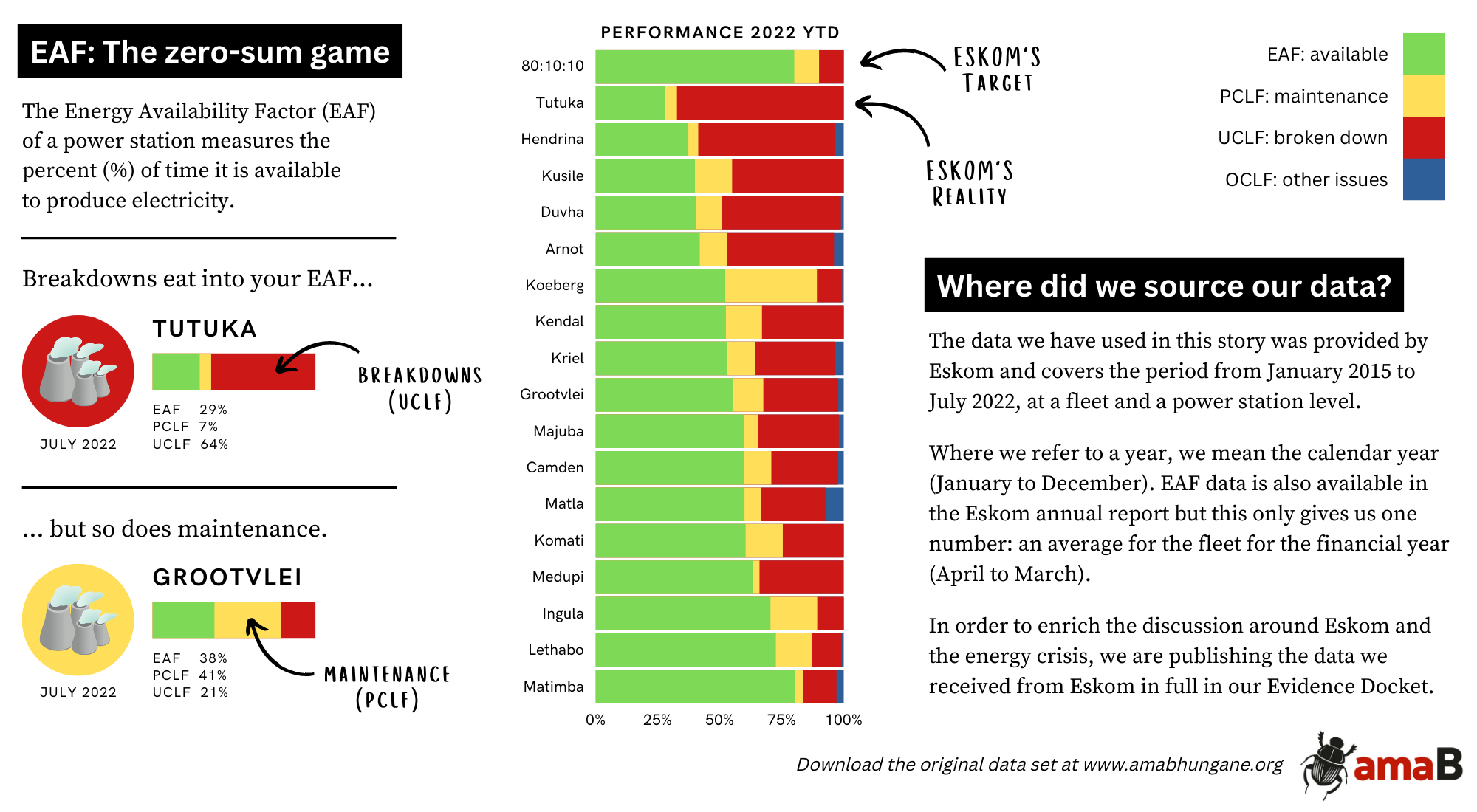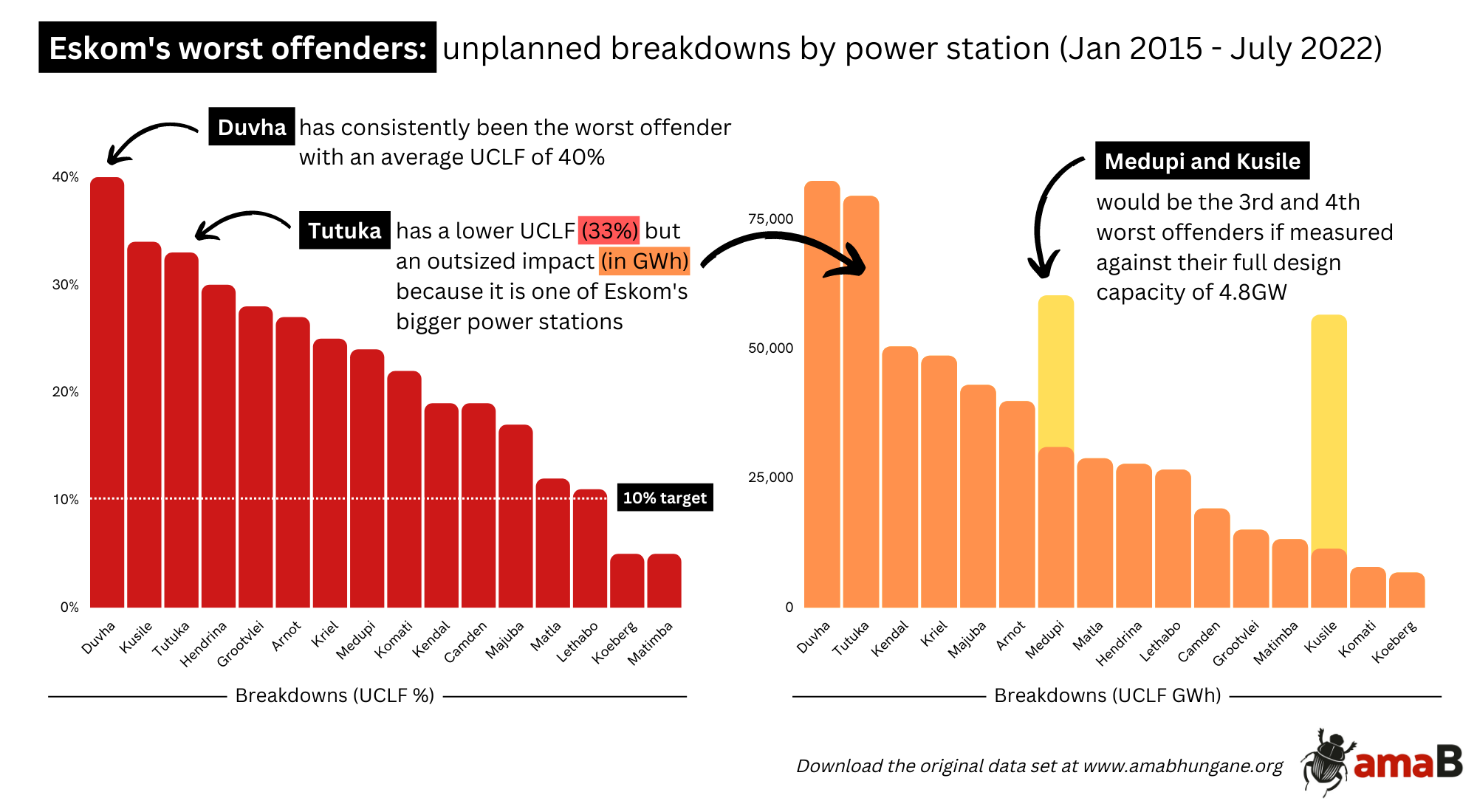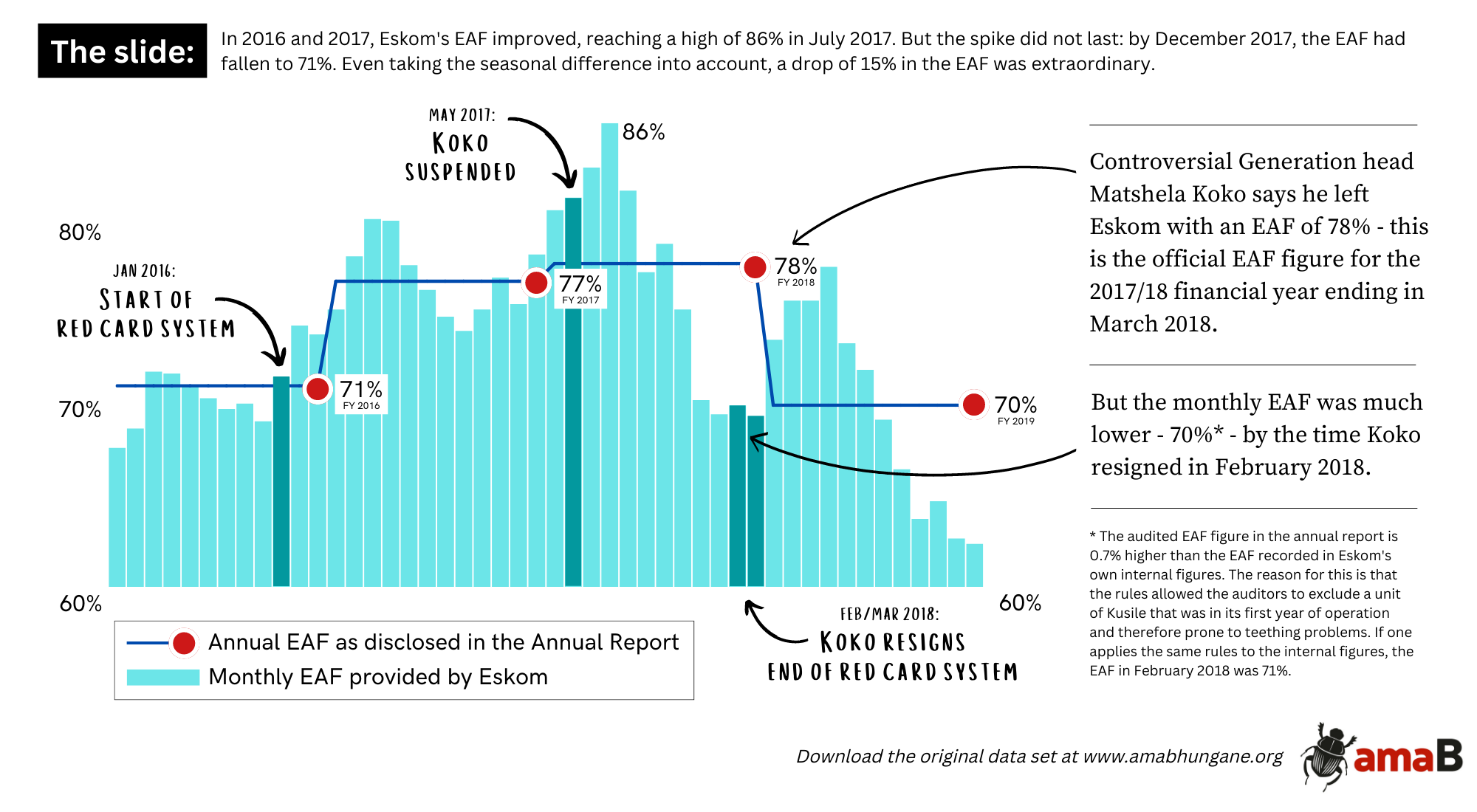AMABHUNGANE
The collapse of old king coal: Eskom’s short but brutal road to ruin

How did Eskom hit energy bankruptcy? To quote Hemingway: ‘Gradually, then suddenly.’ We explain how a toxic combination of politics and blind optimism led us into an energy crisis. Now we must face the fact that Eskom’s coal fleet is failing.
In 2017, Eskom’s energy planning office looked out at the horizon and saw a problem: by 2022, the country would have too much electricity.
Coal contracts would still need to be honoured, power station employees would need to be paid, but there would be no one to buy electricity from the eight gigawatts (8GW) of surplus capacity we would have on the grid.
Various ideas were put forward to solve this dilemma of overabundance: Meridian Economics suggested closing old power plants; PwC suggested cutting maintenance and running the stations at low capacity — while Eskom negotiated deals to sell power to neighbouring countries.
But far from Megawatt Park, out in Mpumalanga’s coalfields, the tide was turning. In October 2017, breakdowns — or unplanned capacity loss factor (UCLF) in technical lingo — hit the 20% mark at Arnot, Tutuka and Medupi, and 40% at Camden and Duvha.
And although each station would rebound to a degree, a trend was emerging: the coal fleet was failing.
It is 2022, and there is no sign of the 8GW surplus. Instead, we have a 6GW shortfall, leading to Stage 6 load shedding and the threat of far worse if we do not urgently build new capacity.
This story is about how we got it wrong: how we ignored what was happening to the coal fleet, clung to unrealistic projections, and walked into an energy crisis of our own making. It is also a warning that our plan to solve the energy crisis is based, in part, on ignoring these past failures and doing exactly what we have done before.
How bad is it out there?
In July this year, when Eskom chief executive André de Ruyter wanted to show the President and his Cabinet how bad things were, he took them to Tutuka power station near Standerton.
Built in 1985, Tutuka is one of the newer and bigger power stations in Eskom’s fleet. With a capacity of 3.5GW, it can theoretically provide enough electricity for Cape Town.
But Tutuka is also a wreck. As of July, it was running less than 30% of the time. Crime syndicates have stripped it of spares and fuel, and in contravention of its operating licence it continues to billow out pollutants over surrounding communities.
“[T]he President has been to power plants in Japan… he’s been to power plants in China, so he knows what a good plant looks like,” De Ruyter told us when we interviewed him in July.
“And I think when he saw what Tutuka looked like, he understood that the Potemkin village that had been portrayed to him — a very pleasing picture was presented, you know… ‘Sure, we can get to an EAF 75%’ — but when he saw what the true state of the plant was, then I think he said ‘okay, now we need some drastic interventions’.”
EAF, or energy availability factor, is a measure of the time that a power plant is available to generate electricity. Planned maintenance (PCFL) eats into that time, as do unplanned breakdowns (UCLF).

In the 1990s, Eskom executives had set a target of “90:7:3”, which meant power plants should be available 90% of the time, with 7% allocated for maintenance and 3% for breakdowns. In 2013, that was replaced with the more modest 80:10:10 strategy. Now, we are now lucky if we achieve 60% energy availability factor (EAF).
As part of his plan to turn around the economy, Ramaphosa wants Eskom’s power stations to achieve an EAF of 70%. In July, Tutuka had an EAF of 29%.
That puts Tutuka on par with solar and wind, which are generally able to generate power between 25% (solar) and 36% (wind) of the time. But while Eskom can predict with a high degree of certainty whether there will be sun in the Northern Cape tomorrow and wind in the Eastern Cape, Tutuka’s breakdowns are far less certain.
Days after Ramaphosa’s trip to Tutuka in July, he announced a new emergency energy plan to “open the floodgates to private investment”, in De Ruyter’s words. The plan is to add at least 15GW of new power generation capacity to the grid, mostly from solar and wind, as soon as possible.
But the plan also includes a second objective: “Improve the performance of Eskom’s existing power stations.” This has been the plan for years, and despite pouring billions into maintenance at stations like Tutuka, Eskom has been unable to reverse the coal fleet’s stubborn decline.
Blame it on coal
With an EAF of 29% in July, Tutuka may be the worst performer in Eskom’s fleet, but it is not an anomaly. As of July 2022, the coal fleet — touted as Eskom’s reliable backbone — achieved a year-to-date EAF of 55%.
The other chronic underperformers in 2022 include Hendrina (37%), Kusile (40%), Duvha (41%), Arnot (42%), Kendal (52%), Kriel (53%), Grootvlei (55%), Komati (60%), Camden (60%), Majuba (60%) and Matla (60%).

Most of these are part of Eskom’s “Big 10” — colossal power plants that were built during the 1970s and 1980s. And while the older ones are reaching their 50-year retirement date, others are supposed to run until 2040.
The breakdown of these power plants has had a devastating impact on the country’s energy supply. In just the past five years, the potential electricity output from the Big 10 has dropped by 33%.
This impact should have been cushioned by the arrival of the Medupi and Kusile plants — the so-called “New Build”. But design flaws mean the twin 4.8GW power plants will never reach that capacity and, once completed, will be about a decade overdue.
While Eskom often points to other factors — striking employees, a shortage of diesel — the reality is that we would not have load shedding if the coal fleet was performing as Eskom told us it would. The question is, why?
Part 1: The perfect storm
In December last year, amaBhungane spoke to three maintenance and generation experts from Eskom to understand how things had gone so wrong. Each pointed to different issues, but all agreed that the seeds of our current crisis were planted 20 years ago — ironically around the time that Eskom was voted global power company of the year.
“It’s very much a misconception that we were brilliant then. Yes, we looked good then, but the writing was already on the wall,” Brad Ross-Jones, chief physicist in Eskom’s generation division, told us. “Decisions made then [explain] where we are now.”
In the early 2000s, Eskom started warning government that it needed to build new power plants.
“Eskom kept on going back to government to say, ‘Listen, it’s getting late. Our modelling is telling us that by 2007, we will see [electricity] demand challenges,” according to Logan Reddy, who is in charge of plant long-term planning.
In 2003, government finally gave the go-ahead for Eskom to build Medupi and Kusile: at 4.8GW each, these were two of the largest coal-fired power plants ever built.
“[T]here was a view to say that was already too late,” Reddy told us. [M]aybe Eskom will look back and say, ‘If we did that decision-making under less duress, there would have been some positive outcomes’.”
Paula Goatley, who now leads Eskom’s Reliability Maintenance Recovery programme, was the power station manager at Majuba at the time. When government gave Eskom the go-ahead, “there was… quite a mass exodus… having to be drawn from our current power station fleet to go into the New Build fleet, which somewhat caught us on the back foot.
“That was when we really started stretching people in the fleet.”
Even as skilled people were leaving, the fleet of older power plants in operation grew, as retired stations were “de-mothballed” to address the growing energy crisis.
“[T]hat wasn’t the common trend… we were definitely using very, very old plants with limited experience internationally to compare to,” Reddy explained. With funding constraints and the loss of skills, “it really becomes that perfect storm”.
As predicted, in 2008 the first wave of load shedding arrived.
A zero-sum game
“When we get to 2010, that became another pivotal period in the storyline. Because by then we realised the New Build was going to be late… we needed to make other plans to start compensating for the lack of capacity,” Reddy explained.
Weary of a repeat of the 2008 load shedding, government pushed Eskom to adopt a new policy ahead of the 2010 World Cup: Keep the lights on at all costs.
The energy availability factor of a power plant is a zero-sum game. Breakdowns eat into the EAF, but so do outages to carry out planned maintenance. When Eskom adopted the strategy of “keeping the lights on”, planned maintenance on the coal fleet was inevitably sacrificed.
“[W]e had already begun starting to make compromises and not doing maintenance the way we were used to doing it,” Reddy told us. “[B]ack in the day, you never had to run a unit for extended periods with a boiler tube leak… you shut it down [with] very little consequential damage. Post ‘keeping the lights on’ — or once we adopted that — it all changed.”
With time, “keeping the lights on” changed to “stop load shedding”.
Today, Reddy said, “we’re constantly running [4-6GW] of corrective maintenance that needs a unit to shut down, but you just keep on running until it’s convenient. The whole time you are causing damage. It’s against all technical principles… it’s against good engineering.
“We consciously said, ‘We will put the plant health — we will put the plant reliability — as a lower priority… And we’ve just over time eroded that even further and had to dig deeper and deeper and deeper.”
Optimism bias
With the benefit of hindsight, it seems obvious that Eskom would run out of runway.
Cutting maintenance on the coal fleet to keep the lights on is a bit like running an energy Ponzi scheme. In the short-term, the EAF figures look good, but Eskom is effectively taking away valuable maintenance time to keep the numbers up. It’s unsustainable.
According to Goatley, “you will get your typical technocrats, your engineers”, who insist that certain maintenance is non-negotiable — “they will be your naysayers… they will be prophets of doom”.
“[Y]ou would do a risk analysis on each project and say, ‘we’ve only got X rand and X space — we can’t afford to do A and B; do we do A or B? Which one is better?’” Ross-Jones added.
In 2013, for instance, the generation division told Eskom’s leadership it needed to push planned maintenance to at least 18% to reverse the declining EAF. It was told it could have 10%, provided it also reduced unplanned breakdowns to 10%.
This would become the 80:10:10 strategy, replacing the now unrealistic 90:7:3.
“I think the sentiment was, ‘this is all we can get, so let’s do our best with this and make it work’. I think there was a belief that ‘we’re going to make this work because we have to make it work — we have no choice for the company or for the country,’” Ross-Jones told us.
“I certainly didn’t expect it to get as bad as it did, I have to be honest.”
In psychology, this is called optimism bias — the unfounded belief that we, personally, are more likely to experience positive outcomes and avoid negative ones.
“[W]ith the best of intentions, that’s what we tried to do,” Ross-Jones said of the 80:10:10 strategy.
“And we did it by grouping the stations into three groups and giving the good performing stations everything that they needed — well, as much as we could — the little ones, a little bit less and the worst performing ones basically saying we could only give you what you can save in terms of reducing the [unplanned breakdowns].
“[B]ut I don’t believe we fully implemented that… we just didn’t have the money or the space to even do that.”
Firefighting
The decline of Eskom’s coal fleet had been slow at first, but by 2015 the house was on fire.
In July, consultants from Dentons, appointed to diagnose the cause of renewed load shedding, described the Eskom generation fleet as “aged”, “run exceptionally hard” and “under-maintained”.
“Historically low” maintenance levels, “coupled with the [‘keeping the lights on’] strategy”, had caused a “sharp increase” in breakdowns. The more “proactive maintenance” got delayed, the more “corrective maintenance” was required.
By 2015, there was a 44% backlog of planned outages across the fleet, according to Dentons. Eskom was now in “firefighting mode”, Mike Rossouw, the former chair of the Energy Intensive Users Group, told Eskom’s board back in March 2015.
Rossouw had been brought in to figure out how Eskom could reverse the decline of its coal fleet. It was possible, his report concluded, if Eskom reverted to a strict maintenance schedule.
Smoke and mirrors
In 2015, Eskom’s new chief executive, Brian Molefe, had come in with a promise to end load shedding. To achieve the turnaround he envisaged, Molefe and his CFO Anoj Singh turned to global consulting firm McKinsey.
The point of the “top consultants” programme — McKinsey’s ludicrous at-risk contract — was primarily to help Eskom grow its revenue. The team of consultants would take a cut of any new revenue it brought in.
Read amaBhungane and Daily Maverick’s investigative series: “The McKinsey Dossier, Part 1: how McKinsey and Trillian ripped R1.6bn from Eskom”
It is now well established that the contract was a farce, and that McKinsey and its local partner, Trillian, were paid R1.6-billion for theoretical savings that would largely never materialise.
A huge part of that fee — R206-million — was for improving the EAF at Majuba power station, the largest and newest of the Big 10 coal plants in Mpumalanga. The idea being that if Majuba could produce more power, Eskom could sell more power.
When McKinsey and Trillian arrived in February 2016, Majuba had an EAF of 63%. When the consultants left in June, the EAF was at 66%. But due to some creative baselining and forward projections, the consultants would claim they had delivered a 31% improvement.
In part, this was achieved by bringing in a team of engineers from Dubai and India who recommended technical changes to the way the plant operated, and consultants to target “employees’ mindset and behaviour”. But in part, the boost in the EAF at Majuba also came from the one thing Eskom had been advised to avoid — reducing planned maintenance.
In the short term, cutting the planned outage on unit 6 at Majuba would save money, and without the downtime needed for planned maintenance, the EAF of the plant looked better on paper. McKinsey would claim a fee for both.
Despite agreeing to pay back the fees it earned, McKinsey still maintains that the work it did at Majuba was valuable: “I am… personally very sad that we could not continue the work and [support] Eskom in significantly increasing the viability factor for the entire fleet,” senior partner Alexander Weiss told the State Capture Commission in December 2020. “[W]e were interrupted there.”
We requested interviews with both Weiss and McKinsey’s local office, but neither responded to our emails.
Eskom’s own experts are sceptical about the value consultants like McKinsey can add: “McKinsey have come in on occasions and given advice, and on paper one would find it difficult to fault. However, the reality of it is that a lot of it is very theoretical… not very practical,” Paula Goatley, the former Majuba power station manager, told us.
“[I]n my personal opinion… McKinsey… have never offered us a sustainable solution… we haven’t seen the payback materialise… I certainly believe if we had reaped the benefits of that, they’d still be around.”
The tweeting engineer
Ironically, the generation fleet had been improving without McKinsey’s help. By July 2016, the EAF of the entire fleet had recovered to 75%. The reasons for this are complex and stray into allegations of manipulation.
In part, the EAF had likely improved in 2016 because Eskom had increased maintenance, culminating with a “maintenance festival” in December 2015.
But the turnaround had also been driven by the new head of generation, Matshela Koko.
Under Koko, power station managers were subjected to a “red card” system. If a unit of a power station tripped or experienced a partial load loss, they would receive a written warning or a yellow card. If they accumulated 10 yellow cards, they would face suspension without pay or dismissal.
Between January 2016, when the red card system was implemented, and May 2017, when Koko was suspended, the EAF of the fleet improved from 71% to 78%, while breakdowns dropped from 12% to 7%.
“I really do believe Matshela Koko [is] a brilliant engineer,” said Goatley, who came up through Eskom’s training programme at the same time as Koko.
“Unfortunately, when he got into a leadership position… he ruled by fear… stroke of a pen… red card, yellow card… you don’t perform, you are suspended — three consecutive suspensions and you’re gone.”
Goatley said that while this made him an effective “change agent” and caused a spike in the EAF figures, it was not sustainable.
“[H]e got rid of some people that were pivotal to this organisation, either directly or indirectly, as many good leaders were not prepared to have their livelihood threatened on an impulse…
“One needs to question the ethics and sustainability of such an autocracy, and also the collateral damage that was done owing to his management decisions.”
Koko has previously said he was inspired by the leadership of Bruce Crooks, Eskom’s head of generation who set the infamous “90:7:3” target in the 1990s (90% EAF, 7% planned maintenance, 3% unplanned breakdowns).
“At the time, the actual numbers were [80:14:6]. The power station managers then were dumbfounded. This seemed like mission impossible, but Bruce Crooks was unreasonable. Every time they complained about the targets, he upped them a little more, and those who could not tag along were forced to leave the organisation,” Koko wrote in an opinion piece in 2018.
At Koko’s instruction, planned maintenance — which had risen to 13% in 2015 — was cut back to 10% in 2017 in line with the 80:10:10 strategy.
“[W]e came to the conclusion that the supply chain of Eskom and the country cannot support [13%],” he told us, adding that in his view maintenance of “more than 10% is not sustainable” to Eskom’s bottom line.
Koko remains defiant about his time at Eskom. “There’s no democracy in running a fleet of 50,000MW,” he told us last week. “I will not accept a power station manager — who is trained, who is competent, who knows what to do — tripping a unit.”
To put that into perspective, 45 of Eskom’s 90 units tripped in a single week this month. Asked whether he thought his management style had contributed to an exodus of skilled people, Koko said: “When I was in charge, some left, but we still had the best operational improvements since 2001.”
He added: “We lost people whose power plants were not performing.”
The problem, according to Goatley, was that power station managers would keep units running, even as risks or small faults emerged.
“[Y]ou put the fear of God into people… they’re keeping the unit on load despite safety, despite everything they’ve learned,” she said.
“[B]eing a power station manager myself… there has to be a certain element of fear… But that’s not sustainable — it’s not sustainable to only run things by fear. You have to invest in your people, you have to give them credibility… and unfortunately, in my opinion, Matshela Koko didn’t do that.”
“At certain power stations, the numbers, in our view, don’t quite add up,” De Ruyter told us. “[T]here’s a suggestion there that plants were run harder; that different classifications were used to avoid the dreaded red card that Mr Koko deployed.”
Eskom’s audit and forensic division reportedly produced a memo outlining various theories of how this manipulation may have occurred. But Eskom leadership has consistently refused to provide a concrete answer in public.
“So, the Tweeting Engineer reckons that he fixed Eskom, but if you fix something, then surely it should be sustainable?” De Ruyter said.
“And if you look at the precipitous decline in EAF after Mr Koko left… then you’ve got to ask the question: if things were done so well and so properly, how come, when he left, the wheels came off?”
The surgeon’s blade
Although the EAF had improved in 2016 and 2017, Eskom had other problems. With a bloated wage bill and major cost overruns at Medupi and Kusile, it needed to cut its budget.
In 2009, the energy regulator introduced the first multi-year price determination (MYPD) to force Eskom to justify the tariffs it charged to consumers.
“[E]ffectively from the first MYPD, we never got the tariffs that we told the country or told the regulator that we needed,” Reddy told us.
After McKinsey was shown the door in 2016, consultants from PwC stepped in. The PwC “capital scrubbing” project, which began in February 2017, was more mercenary in its aim: to cut R65-billion from the capex budget.
- Like McKinsey, PwC would work “at-risk” and earn a cut of any savings it made. Perhaps not coincidentally, a large cut of both contracts would end up in entities that benefited State Capture kingpin Salim Essa, first Trillian and then Nkonki. Read The Nkonki Pact Part 2: Eskom’s new billion-rand consulting deal for Essa & Co
“[T]hat was… against a baseline of an extremely lean capital programme anyway,” Reddy said. “[W]e were already on the backfoot… based on the tariffs that were given to us. And then we were asked to scrub over and above that.”
Nothing was sacred: R7.5-billion for the long-promised fabric filter plant at Tutuka to bring emissions within legal limits, R3-billion to expand the grid for renewables, R1.4-billion to build a new ash dam at Kriel — PwC recommended that each project be scaled back or cut entirely.
In one example from May 2017, PwC told Eskom: “The switchgear [at Tutuka] has a non-compliant arc flash rating, which indicates that the equipment is unsafe to use due to risk [of] arc flashing which can cause harm to personnel.”
To replace the switchgear would cost R1-billion. Instead, PwC recommended that Tutuka’s staff implement an “11-point safety plan” when operating the old, unsafe switchgear. For identifying this R1-billion saving, PwC would be entitled to claim a R75-million success fee.
- Investigators from G9 Forensic, who were brought in to investigate the PwC contract when it was cancelled, described this fee structure as “patently unlawful and stupendously egregious”. For more, read: Eskom demands PwC pay back R95-million in consulting fees
PwC maintains that none of their proposed cuts would have compromised the safety of staff or the long-term reliability of Eskom’s plants.
“It was a critical aspect of the project that the capital scrubbing should be achieved without compromising on reliability, safety and security and Eskom’s ability to supply energy to South Africa,” PwC’s chief operating officer Fulvio Tonelli told us at the time.
“Significant risk management measures were put in place to manage this and mitigate any risk of ‘savings at all cost’.”
But the consultants were straying into dangerous territory. By far the biggest target on the PwC list was R42-billion set aside for planned maintenance and capex at the six coal-fired power stations.
Believing that Eskom would soon have too much electricity, thanks to the improved EAF, PwC told Eskom in July 2017 that it could afford to mothball three power stations — Hendrina, Komati and Camden — and cut output to 50% at Tutuka, Kriel and Camden.
This would allow Eskom to reduce maintenance even more, scrubbing R9.7-billion from the capex budget over five years, while also generating astronomical fees for the consultants. But fearing a repeat of McKinsey’s at-risk fee debacle, Eskom’s legal department recommended the contract be cancelled.
What no one realised was that July 2017 was as good as it would get. By the time PwC left in September 2017, unplanned breakdowns were rising.
The slide
Koko maintains that he left Eskom in February 2018 with an EAF of 78%. In a way, that is true: the average EAF for the 2017/8 financial year (ending in March 2018) was 78%. But that figure obscures the more granular detail of what was happening to the fleet.
In July 2017, the EAF hit a peak of 86%. By February 2018, it had dropped to 70%.
EAF has seasonal peaks and troughs, coinciding with winter when demand rises, and summer when demand drops and maintenance rises. But even taking that into account, the decline was extraordinary: in 2016, the difference between the winter peak (July) and summer trough (December) was 5%. In 2017 it was 15%.

The red card system continued after Koko was suspended in May 2017. He would make a brief comeback as Eskom’s CEO in December 2017. By the time he resigned from Eskom in February 2018, any improvement brought about by the red card system had been erased. The following month, in March 2018, the red card system was scrapped.
Koko refused to engage with Eskom’s monthly EAF figures: “You can only work with Eskom audited financial statements… The rest I don’t accept,” he told us.
But if we only looked at one EAF figure — the average for the year — we would miss the signs that things were changing. By early 2018, when Koko left (and then president Jacob Zuma resigned), the signs were clear: the EAF improvement that everyone thought heralded a new era for the coal fleet, was coming to an abrupt end. DM
AmaBhungane is a nonprofit centre for investigative journalism. We co-publish our investigations, which are free to access, to news sites like Daily Maverick. For more, visit us on www.amaB.org.
(The story continues — look out for Part 2 coming soon.)



















 Become an Insider
Become an Insider
An excellent, detailed analysis. I look forward to part 2
As de Ruyter justifies himself with excuses and attacking Koko, he needs to tell us what went wrong at Sasol and Nampak. Leaving that aside, de Ruyter took over Eskom fully aware of the challenges and what was expected of him. To harp on history is like the ANC blaming Apartheid for all its failures. That does not wash. His first task ought to have been a skills audit at the technical and governance levels, then work out a clear plan to deal with the challenges. It is shocking that after four years we are told of skills and a board that has been incomplete and without the requisite skills by Gordhan and de Ruyter. This ought to have been the first thing to do and to look at whether Professor Makgoba who has failed to get an HIV vaccine was fit to chair a massive engineering undertaking like Eskom.
The second issue was to have a risk management audit of the fleet and age analysis to examine whether there is a need to retrofit some of the power stations. From a risk management perspective, the issues and reasons for tripping are the very legal basis for the dismissal without notice of de Ruyter.
We have a challenge in the Department of Public Enterprises under Pravin Gordhan with a suspended DG and allegations around him and SAA. When he placed the SAA in business rescue, Cyril was apparently was not briefed on such a major decision and denied it on television. It is nice when you have a President in your back pocket like Pravin because you get away with many things .